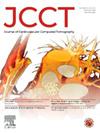心脏计算机断层扫描评估人工心脏瓣膜。心血管计算机断层扫描学会(SCCT)、美国心脏病学会(ACC)、欧洲心血管放射学会(ESCR)、北美心血管成像学会(NASCI)、北美放射学会(RSNA)、心血管血管造影与干预学会(SCAI)和胸外科学会(STS)的专家共识文件。
IF 5.8
2区 医学
Q1 CARDIAC & CARDIOVASCULAR SYSTEMS
引用次数: 0
摘要
随着世界范围内人工心脏瓣膜植入数量的增加,人工心脏瓣膜功能障碍越来越明显。心脏CT成像已成为评估phv和确定功能障碍原因的有价值的工具。本共识文件首先总结了PHV评估的可用技术。然后详细讨论了CT在PHV(天)功能评估中的应用,包括正确适应症的共识声明和PHV CT评估的患者选择,图像采集,重建和测量方案,以及如何解释和报告特定类型PHV功能障碍的CT表现。本文章由计算机程序翻译,如有差异,请以英文原文为准。
Cardiac computed tomography for prosthetic heart valve assessment. An expert consensus document of the Society of Cardiovascular Computed Tomography (SCCT), the American College of Cardiology (ACC), the European Society of Cardiovascular Radiology (ESCR), the North American Society of Cardiovascular Imaging (NASCI), the Radiological Society of North America (RSNA), the Society for Cardiovascular Angiography & Interventions (SCAI) and Society of Thoracic Surgeons (STS)
Prosthetic heart valve (PHV) dysfunction is increasingly seen due to the increase in the number of PHV that are being implanted worldwide. Cardiac CT imaging has emerged as a valuable tool to assess PHVs and determine the cause of dysfunction. This consensus document first summarizes the available techniques for PHV assessment. Then the use of CT in PHV (dys)function assessment is discussed in detail including consensus statements for correct indications and patient selection for CT assessment of PHVs, image acquisition, reconstruction and measurement protocols and how to interpret and report the CT findings for specific types of PHV dysfunction.
求助全文
通过发布文献求助,成功后即可免费获取论文全文。
去求助
来源期刊

Journal of Cardiovascular Computed Tomography
CARDIAC & CARDIOVASCULAR SYSTEMS-RADIOLOGY, NUCLEAR MEDICINE & MEDICAL IMAGING
CiteScore
7.50
自引率
14.80%
发文量
212
审稿时长
40 days
期刊介绍:
The Journal of Cardiovascular Computed Tomography is a unique peer-review journal that integrates the entire international cardiovascular CT community including cardiologist and radiologists, from basic to clinical academic researchers, to private practitioners, engineers, allied professionals, industry, and trainees, all of whom are vital and interdependent members of our cardiovascular imaging community across the world. The goal of the journal is to advance the field of cardiovascular CT as the leading cardiovascular CT journal, attracting seminal work in the field with rapid and timely dissemination in electronic and print media.
 求助内容:
求助内容: 应助结果提醒方式:
应助结果提醒方式:


